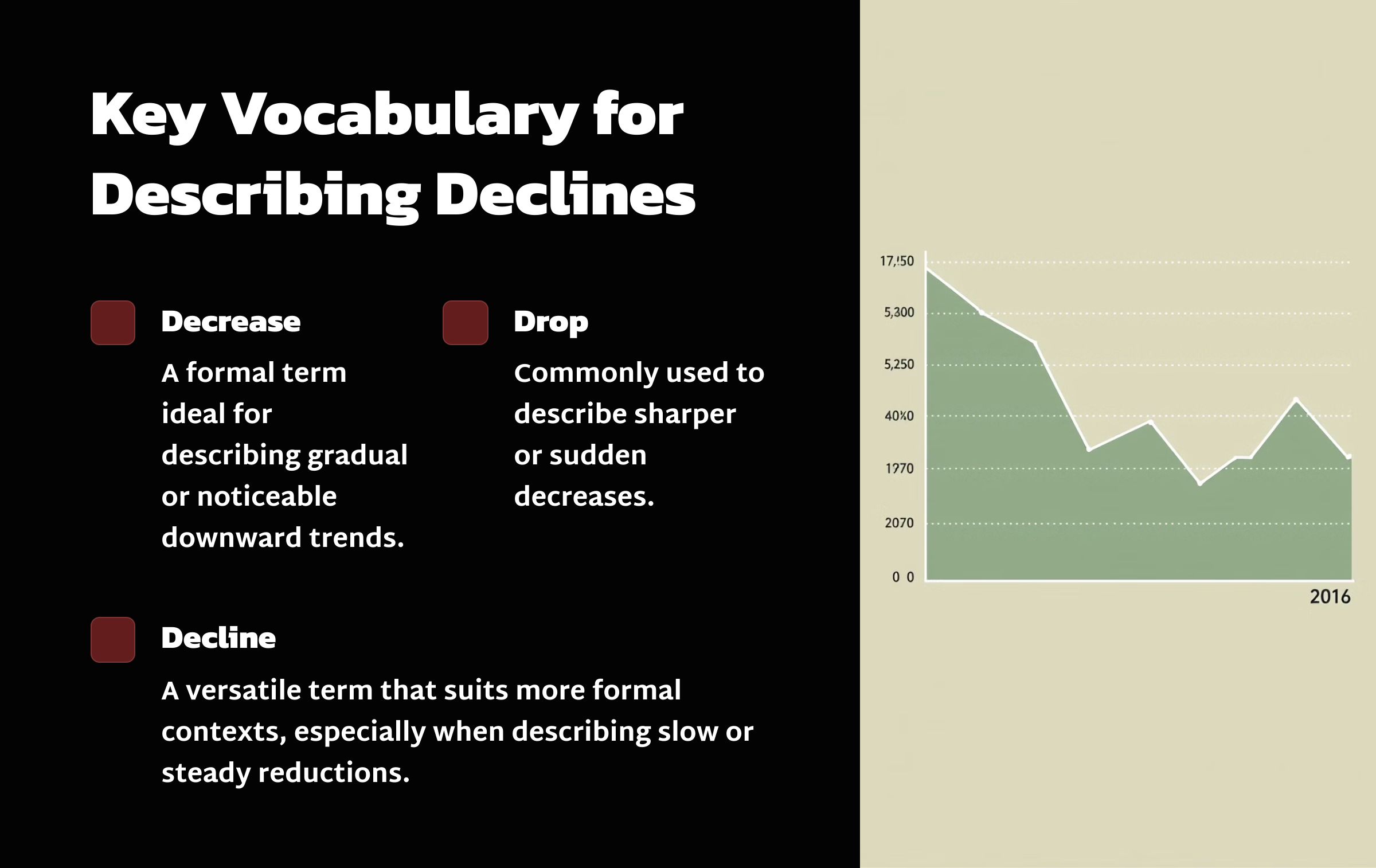

Mastering Vocabulary for Describing Declines in IELTS Academic Writing Task 1
Interpreting graphs, tables, and charts in IELTS Academic Writing Task 1 demands precise language to describe trends, particularly downward movements. Accurate descriptions not only demonstrate advanced language proficiency but also reflect your ability to analyze data critically. Below is a comprehensive guide to key terms used to articulate declines, tailored for college-level students specializing in linguistics or academic English. Mastering this vocabulary will help you present nuanced and detailed analyses of trends effectively.
Key Vocabulary for Describing Declines
Decrease
Phonetics: /ˈdiːkriːs/ (noun), /dɪˈkriːz/ (verb)
Part of Speech: Noun/Verb
Definition: To become smaller or less in size, amount, or degree.
Word Patterns:
[noun]: “a decrease in + [noun]”
[verb]: “to decrease by + [amount]”
Example: “The chart highlights a decrease in the number of students enrolling in arts courses.”
Usage: This formal term is ideal for describing gradual or noticeable downward trends. Use modifiers like “slight,” “moderate,” or “significant” to indicate the extent of change. For instance, “a significant decrease in profits” adds specificity. Prepositions such as “from” and “to” are commonly used to define the range (e.g., “a decrease from 40% to 25%”). Additionally, “decrease” is often paired with adverbs like “gradually” or “dramatically” to further clarify the nature of the trend. Its flexibility makes it a staple for academic writing.
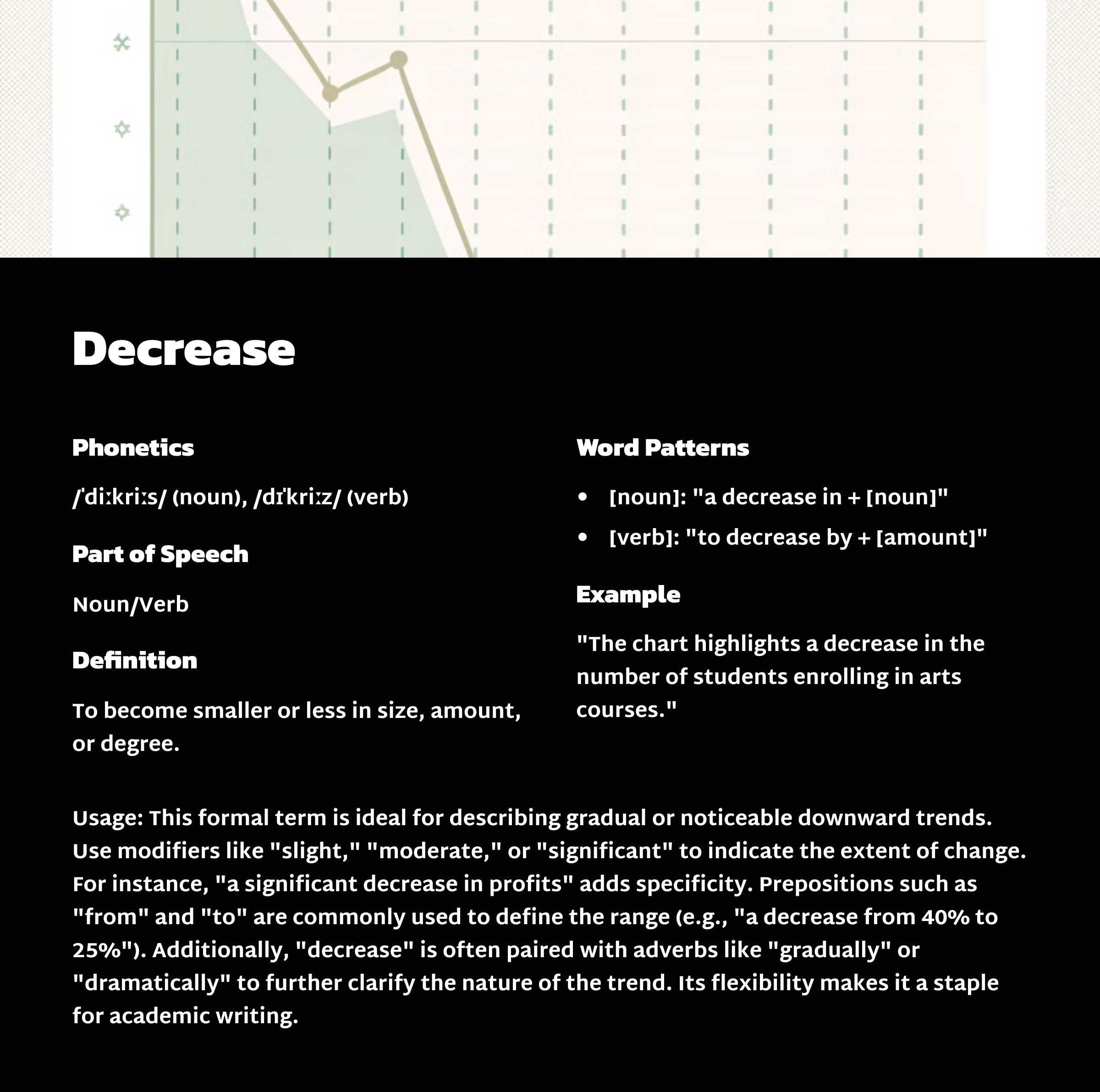
Drop
Phonetics: /drɒp/
Part of Speech: Noun/Verb
Definition: A fall or reduction in level, amount, or value.
Word Patterns:
[noun]: “a drop of + [amount]”
[verb]: “to drop by + [percentage]”
Example: “Passenger numbers dropped by 20% following the fare hike.”
Usage: “Drop” is commonly used to describe sharper or sudden decreases. It is particularly effective in emphasizing abrupt changes within short timeframes (e.g., “a dramatic drop within a week”). Pair it with adjectives like “steep,” “sudden,” or “unexpected” for clarity. For example, “a sudden drop in temperature overnight” conveys urgency and immediacy. This term is especially useful for informal contexts while retaining clarity and precision for academic use. Additionally, “drop” can highlight significant short-term changes, making it suitable for high-impact datasets.
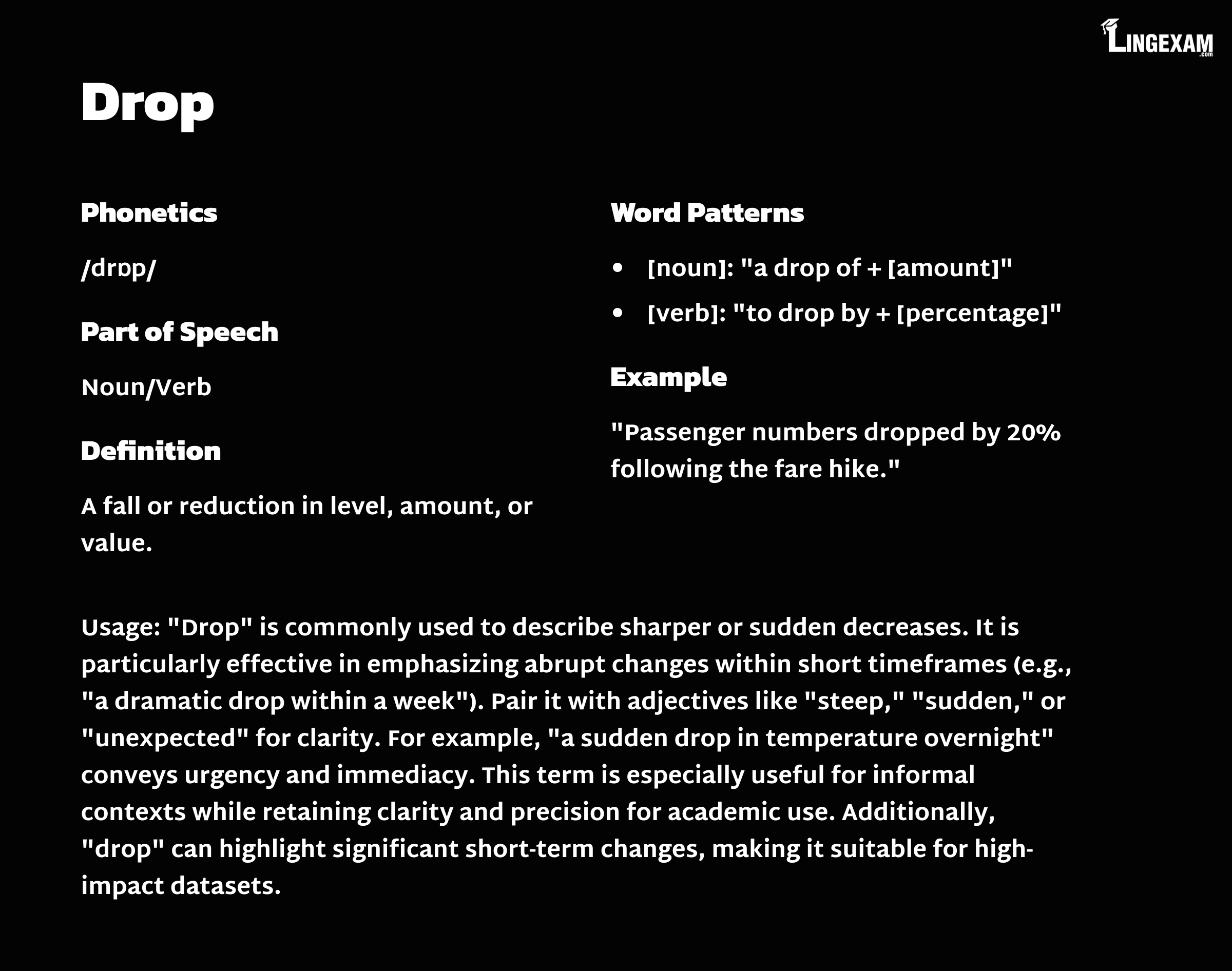
Decline
Phonetics: /dɪˈklaɪn/
Part of Speech: Noun/Verb
Definition: A gradual reduction in the level or amount of something.
Word Patterns:
[noun]: “a decline in + [noun]”
[verb]: “to decline by + [percentage]”
Example: “Employment rates have declined steadily over the past five years.”
Usage: “Decline” is a versatile term that suits more formal contexts, especially when describing slow or steady reductions. It pairs well with adverbs such as “steadily,” “gradually,” or “consistently” to describe trends over longer periods. For example, “a consistent decline in production” suggests a long-term decrease. This term is also effective for non-numerical trends, such as “a decline in public interest.” When describing subtle or complex changes, “decline” is particularly effective, offering a sophisticated alternative to simpler terms like “drop.”
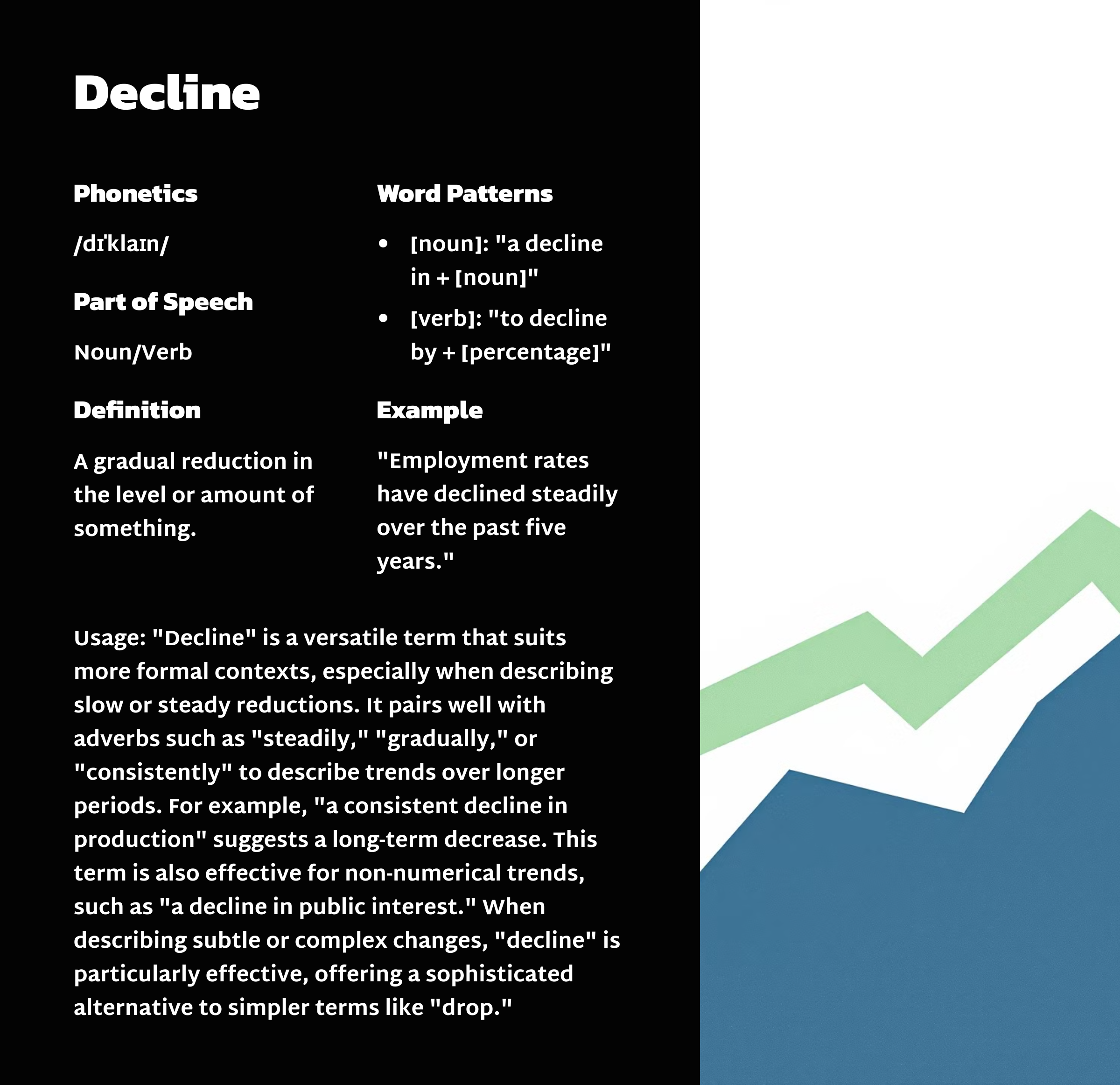
Additional Tips for Describing Declines
Use Precise Modifiers: Enhance your descriptions by adding context with modifiers like “sharp,” “steady,” “gradual,” or “dramatic.” For instance, “a dramatic drop” signals a significant and sudden change. Modifiers help to convey the scale and intensity of the decline, making your descriptions more vivid.
Time References: Specify timeframes to add depth to your analysis. Phrases like “over the last decade,” “in the previous quarter,” or “within a single year” provide clarity about when the changes occurred. Including time markers ensures your descriptions are contextualized and easy to follow.
Comparative Language: Use comparisons to highlight differences in data. For example, “The rural population experienced a larger decrease compared to urban areas.” This approach emphasizes disparities and adds analytical depth to your writing.
Synonyms and Variety: Diversify your language by alternating between terms like “decline,” “drop,” and “decrease.” This variety demonstrates a strong command of vocabulary, a key component of higher IELTS scores. Using synonyms also prevents repetition and maintains reader engagement.
Prepositional Precision: Be mindful of prepositions such as “by,” “from,” and “to.” These small words are crucial for accurately describing the extent and range of declines.
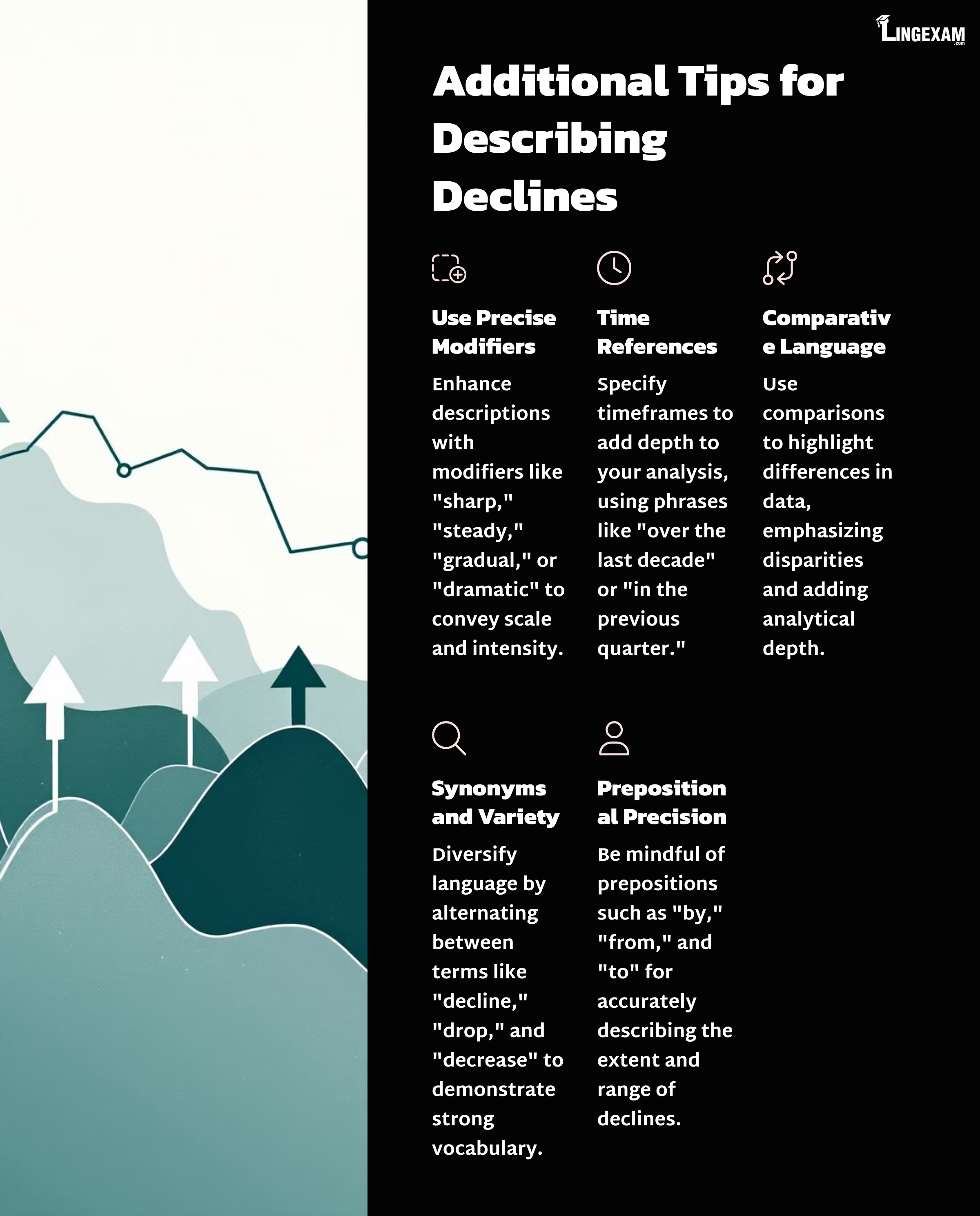
Practical Application
Mastering these terms and their appropriate contexts allows you to effectively describe downward trends in any dataset. Practice incorporating them into sentences, emphasizing prepositions (e.g., “by,” “from,” “to”) and modifiers to create nuanced and professional descriptions. For example, “The percentage of renewable energy usage decreased from 30% to 20% over the course of five years” provides a precise and complete analysis.
Developing this skill not only enhances your IELTS Academic Writing Task 1 responses but also prepares you for academic and professional scenarios where interpreting and describing data trends is crucial. By practicing with diverse examples, you can build confidence and adaptability in writing about declines in various contexts. This ability will set you apart as a clear and analytical communicator.
You May Also Like
- Dec 2, 2024
- IELTS
Sign up to receive our latest updates
Get in touch
Address

